Typing Tournament will help your child to learn the vital skill of touch typing.
They will have so much fun they don’t even know they are learning.

Learn to type anytime and anywhere there is a computer or tablet. Get started with your free 30‑day trial today!
The fun way to master typing!
Typing Tournament teaches the vital skill of touch typing and enhances keyboard skills. It uses a unique combination of mastery learning, teaching sequences and games to motivate both children and adults. Users are actively guided through typing activities for optimal learning and ensures that they are using the right fingers on the right keys.
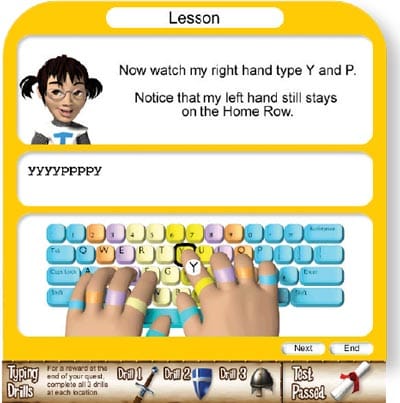
Typing Tournament progresses through 16 levels each introducing four keys with a lesson, practice keys, three drills, three games and a progress test that are all directly linked to the mastered and introduced keys.
Complete the quest and prove yourself worthy of challenging the Dark Typist! Journey through 16 medieval environments, from the Dragon’s Cave to the Throne Room. Only you can rid the land of the Dark Typist’s tyranny!



Kids have so much fun that they don’t even know they are learning.
Your progress through the 16 levels is based on a revolutionary Multiple Progressions Model that assumes that mastery of existing keys must be demonstrated before new keys are introduced.
As users progress through the levels the required typing speed increases and muscle memory critical for typing success is developed.
For school users we have locked the initial speed goal. Once Level 16 is passed at 22 WPM higher speed goals to over 100 WPM are accessible.

Uses a powerful combination of mastery learning, teaching sequences and games to teach the vital skill of touch typing.
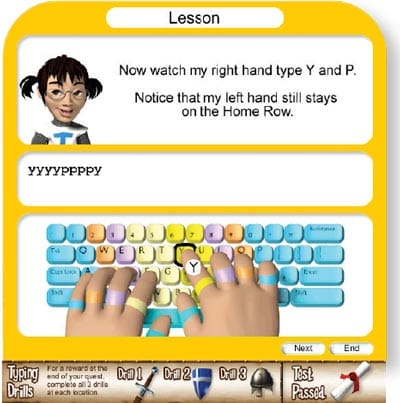

Typing Tournament is based on mastery learning and on the assumption that before progression and the introduction of new content, mastery of the old must be demonstrated.
The progress through the activity sequences is controlled by carefully researched parameters that are adjusted to give optimal learning
For school users we have locked the Speed Goal for the Level 1 Test (Mountains) is set to 6 WPM and gradually increases Level by Level to 22 WPM for Level 16 (Throne Room)
Higher Speed Goals up to 48 WPM can be unlocked by completing the Level 16 Test. Once you have chosen your new Speed Goal, Levels 1 – 16 will be locked or unlocked depending on your previous achievements at that Level.
Once the Speed Goals are unlocked Typing Tournament Online dynamically regulates the Drill and Test achievement thresholds to help you master the keys at your new elevated Speed Goal. It tracks your progress and then appropriately challenges you to build the muscle memory required to type faster and faster. Most other typing programs have limited progress tracking and a simple linear progression or no progression at all. With Typing Tournament Online its unique underlying Multiple Progressions Model dynamically varies the Drills, Games and Tests to tailor tuition for each typist!


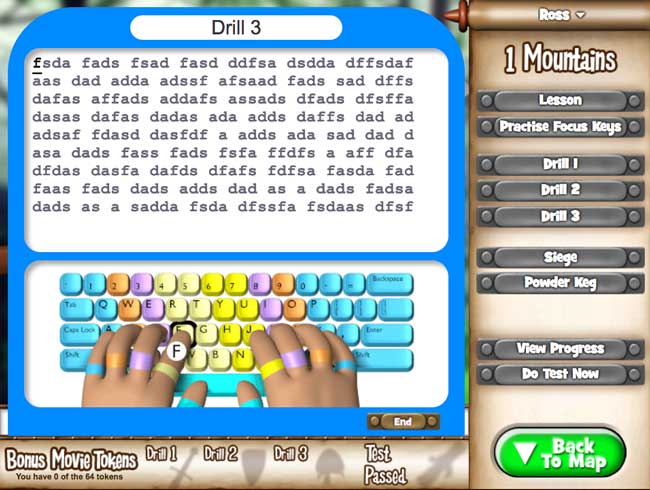

Powerful reports put teachers in touch with the results accrued by each student. The reports enable detailed analysis of questions answered. Teachers can relate progress to curriculum outcomes.

In each Level typists are systematically guided through the Lesson, Practise of Focus Keys, Drills and Test
Embedded are a series of instructions to encourage the formation of good posture and ergonomic habits the should be developed by all typists.





Typing Tournament retains all the power and flexibility of the multi-award-winning CD version but has been massively enhanced by the addition of over 100 changes resulting from our extensive classroom testing and research. For children it is more engaging and actively ensures that they use the right fingers on the right keys. For teachers it is more capable, much easier to administer, and saves supervision time in the classroom.
EdAlive Central is the powerful platform underpinning all EdAlive websites that streamlines and centralises the admin side of things.


Like all EdAlive online learning websites, Typing Tournament:
Progresses typists through carefully sequenced text that builds kenetic memory

The focus keys of the 16 levels are:
At the heart of Typing Tournament is a 38,000 word bank of carefully controlled, precisely sequenced text that has been designed to reinforce the learning of the key strokes, build muscle memory and engage the learner.
The text has been intentionally created to motivate learners of all ages by engaging them through content that is full of interesting facts and peppered with humour.
As users progress through the levels the required typing speed increases and muscle memory, critical for typing success is developed.

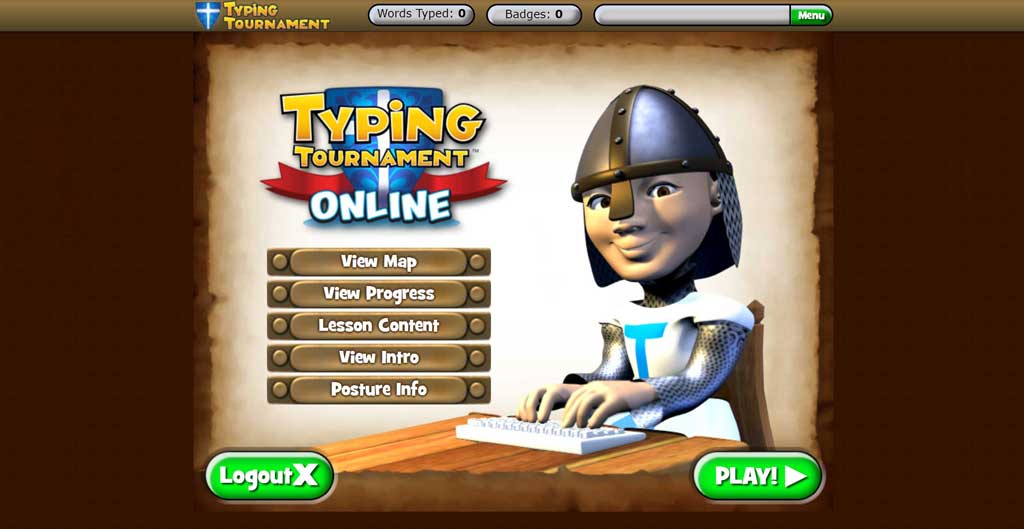
The Typing Tournament lesson sequence has been designed to give learners maximum reinforcement of muscle memory.
Drill concepts and overall program structure in Typing Tournament are designed around the belief that the only route to typing mastery is via regular repetition of individual muscle movements and the frequent reinforcement of hand-to-brain correspondences.
These associations are developed in two different ways: firstly by ensuring that the correspondences between eye, brain, fingers and keys are carefully and unequivocally established in the first place; secondly by ensuring that time is spent systematically consolidating them.
In all the drills users are encouraged to try to strike each letter correctly on the first attempt, on the premise that to strike a key correctly the first time is a far more effective learning experience than to strike it incorrectly then retype it. In the drills incorrect keystrokes do not register. The program will only accept the correct letter, and if the user hesitates for more than 2 seconds there is an animated prompt to indicate the correct letter and the correct finger.
The home row is the starting point for instruction, with the space and shift keys introduced early to build the swiftest possible route to typing meaningful content organised in words, word groups and phrases. The sequencing of letter groups is also designed to give early access to common English letter strings.


It is a common experience for both children and adults to begin typing courses and fail to complete them. When a typing course has no intrinsic adaptability, a negative learning cycle can be established whereby users cover the same introductory content over and over again, but fail to progress to real typing competence.
Typing Tournament Online’s Multiple Progressions Model has been designed to break this negative cycle and is specially developed to give users of all ages and stages maximum flexibility in establishing and reaching their typing goals.
The Multiple Progressions Model is built around 3 principles. Firstly users are allowed to choose how steep a learning curve they wish to attempt to climb. Secondly they are allowed to access that learning curve at any point where they can demonstrate their competence to be there. Thirdly, they can choose to raise or lower their goals at any point in their journey.
As students progress through the levels the speed and accuracy goals increase. Once students complete level 16 at 22 wpm they can choose higher speed goals all the way to over 100 wpm

The Multiple Progressions Model means that all users access the same sets of content for each of the 16 game environments. However, by choosing different speed and accuracy goals, they select different rates of progress.
So user 1, choosing the speed goal E of reaching 48 wpm in the 16 lessons, will need to complete the level 7 test at 27 wpm, whereas speed goal A user 2 needs to do the same test at only 12 wpm.
And a user who finds the demands of the later environments too difficult at speed goal E can drop down to a lower speed goal until they develop the requisite skills rather than being forced to go backwards and becoming bored or completely abandoning their objectives.
We have adopted a generic keyboard design and have deliberately excluded keystrokes located in different positions on the keyboard in different countries (for example, currency symbols, the exclamation mark and double inverted commas).
Basic punctuation is specifically taught, not just left to chance and the problem-solving capacities of the user. It is our belief that these fundamental keyboarding functions need to be explicitly secured so that there are no areas of indecision to interrupt the user’s typing speed and rhythm.
We have adopted the stylistic convention of using a single space between sentences as it is our view that the former convention of double-spacing sentences in typewritten material has been superseded in modern word-processing and publishing usage by the single space.
Basic punctuation is specifically taught, not just left to chance and the problem-solving capacities of the user. It is our belief that these fundamental keyboarding functions need to be explicitly secured so that there are no areas of indecision to interrupt the user’s typing speed and rhythm.
Typing Tournament has been carefully researched and constructed to make the teaching of typing as time efficient and easy as possible. It reduces the supervision required by teaches by actively ensuring that children use the right fingers on the right keys.


The teaching of accurate, rapid keyboarding skills is supported across all curricula.
Each Australian State and Territory maintains it own department of education and is responsible for its own curriculum. Most fulfil this requirement by referring to the ACARA administered Australian Curriculum. NSW and Victoria use the Australian Curriculum as a base and then overlay their own structures on top of it.


Children and adults and who have good 10 finger typing skills can complete their work faster and so have a massive advantage at school and in life. Because they can type, they will complete their work faster and more accurately and are therefore more confident and able to perform literacy tasks that daunt others. Good typing skills are critical for today’s learners and tomorrow’s earners.
Children are now working with keyboards and touch screens on iPads before they can walk! This may help their learning but in the process they can develop very poor keyboard skills. The way they learn to interact with the keyboard by pointing and poking stays the same as they grow and is a huge constraint on their learning and productivity. Accurate and rapid keyboarding skills are vital for today’s learners and tomorrow’s earners.
There is also a generation of adults working in industry, academia and the public service who lose thousands of hours from their lives as they hunt and poke at the keyboard whilst life passes by and the cost of their reduced productivity accrues personally, corporately and societally. Leaning to touch type can greatly reduce the hours spent hunting and poking on a keyboard.
Typing Tournament can rewire kids’ and adults’ brains when poor typing habits have taken hold, giving them correct muscle memory and enabling them to type efficiently.

Community and educational expectations regarding the necessity of teaching typing skills are changing rapidly. This change is being reflected in curriculum statements, educational practice and online testing including NAPLAN and the HSC.
The following links will take you to succinct summaries of the growing body of material addressing the teaching of the vital skill of typing in our schools.
The United States Common Core State Standards form the basis for education in the USA with most States adopting them as their standard or in dissenting States, as a minimum.
Research shows that students who can type efficiently experience a massive boost to NAPLAN Writing Task results.

Completing NAPLAN Online is a significant challenge for schools, teachers and children. Who would contemplate using a written test without first training students to be proficient in the use of a pencil? It is the same with online testing. Students must be proficient in the use of the keyboard or have impeded results.
Generally Australian students have poor typing skills due to the laissez faire approach to the teaching of typing in most schools. Historically this laxity has its roots in the lack of specific detail in the curricula and syllabi yet the imperative for the teaching of typing skills is clear in all curicula.
ACARA’s offical advice on the impact of typing skills on the NAPLAN performance is that typing skills do not effect NAPLAN results. This position is directly contradicted by the findings of the independent NAPLAN Review Final Report 2020.
In 2019 the governments of ACT, NSW, QLD and VIC commissioned an independent report to assess the efficacy of NAPLAN. The report is now available and found that keyboarding skills are critical for students completing NAPLAN Online. See page 84 of the NAPLAN Review Final Report 2020.
“Those students in Years 5, 7 and 9 who have prior opportunities to develop typing fluency and word processing skills by regularly using a keyboard are better placed to produce sustained writing online.
The explicit teaching of keyboarding skills and monitoring typing proficiency beyond Year 3 are essential in developing students’ writing skills and for equitable participation in computer-based writing assessments.”


Literary Progressions HwK1 to Hw8 now require that students develop fluency, automaticity and accuracy in keyboarding skills. This can only be achieved by the teaching of touch typing.
The content descriptors and elaborations of the Australian Curriculum focus mostly on keyboard awareness but underlying them is the assumption that students can type effectively. The assumption is that these outcomes are achieved through the teaching of touch typing.
An analysis of the NAPLAN results for students using Typing Tournament against those from similar schools shows a 35% increase in the Writing Task score. Read the research findings:
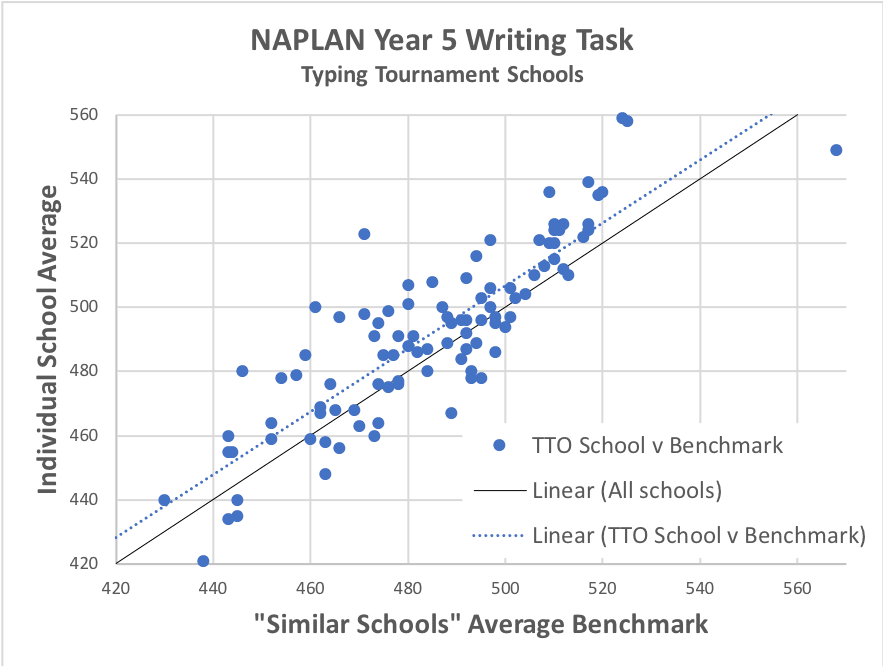
The Typing Challenge gives schools the perfect opportunity to boost students’ typing skills. Research shows you’ll also boost your NAPLAN results. It’s open to any class or classes from any school, anywhere.
Kids just start typing and keep going! Each word typed by a student in counts towards the class average speed and words typed total during the Challenge week. Type from school or home on any device, including iPads.
If your school/class does not already have a subscription then start a FREE Trial. . Participation is completely free and without obligation. FREE Trials are normally limited to 30 days but during Term 1 2024 we will extend them to Monday 11th March to cover the Typing Challenge.



With NAPLAN online, now is the perfect time to get your class’s typing skills up to parr, give your NAPLAN results a boost and have fun.
Research has shown that Year 5 students who have learned to type with the leading touch-typing tutor, Typing Tournament, have a clear advantage and a pathway to improved NAPLAN scores. The average NAPLAN result in the Writing Task for a class using Typing Tournament will be boosted by 7 NAPLAN marks.
That’s a boost of 37% of a year’s progress.
Once your class has started typing, the Typing Tournament system keeps track of your class’s progress and displays it in real-time and in rank order on the Leaderboards. The winners of the Typing Challenge are the Leaderboard winners for the week of the Typing Challenge.
Starts Sunday March 3rd and ends 10:59:59am AEDT Saturday March 9th 2024. The system uses GMT (Grenwich Mean Time)
There are separate Leaderboards measuring the average typing speed of your class and the total words typed by your class.
Each Leaderboards is broken down by country, state, school and age group.
The Leaderboards allow users who are logged in to see the ranking of classes within their school allowing intra-school competition. Join up as many classes as you can and max the competition!

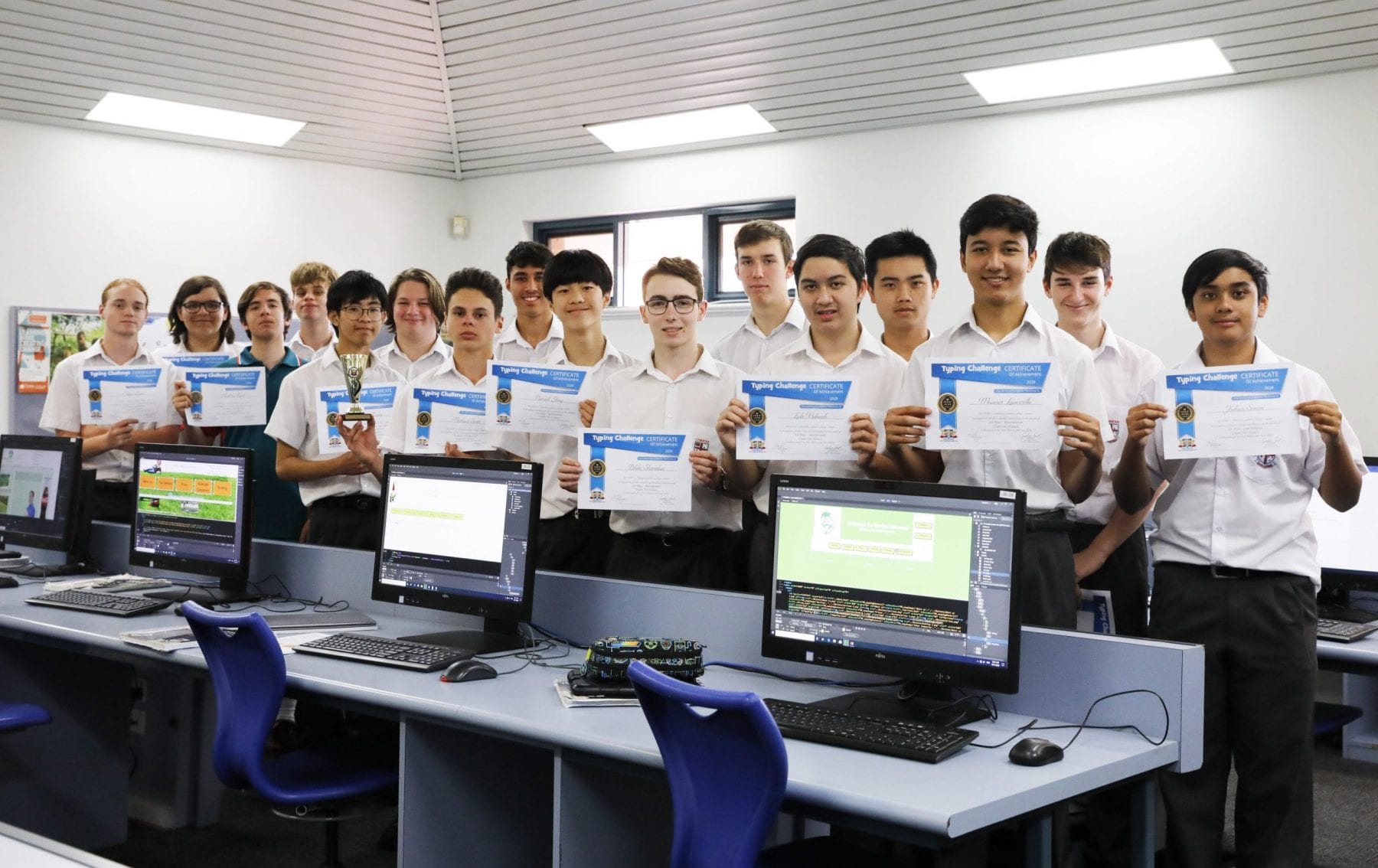
“The students were great all year. They really enjoyed Typing Tournament and all increased their speed dramatically.” – Mike Burgermeister (Chisholm Catholic College)
At the end of the Typing Challenge week Gold, Silver and Bronze winners are awarded to the top 3 Leaderboard ranks for both fastest average speed and most words typed categorised by age-group and State.
Results will be posted to the EdAlive website (edliave.com) during the week following the Typing Challenge.
Teachers can print individual Typing Challenge Certificates for each student from their Teacher account.
As the Leaderboards rank the results of all classes, you are able to celebrate the achievement of your class even if it is not a category winner.
Start using Typing Tournament right now to prepare the students for a final push in the Challenge Week. From one class to the whole school - all may participate in the Typing Challenge.
Only results for classes are shown. No individual results are visible.
We employ standard deviation filters to ensure that results that are atypical for a student are discounted and not used for the calculation of class results. This methodology assumes that each student will build their skills in a progressive manner. This mechanism guards against the possibility of others with higher typing speeds artificially inflating a class result by typing in their account or students randomly mashing the keys to artificially boost their typing speed and output.

The use of Typing Tournament rapidly boosts students’ typing speeds, but the best outcomes emerge from strong support in the classroom, where students are encouraged to correctly use the touch-typing principles built into the programme. When this happens, students make even more remarkable gains and master the art of typing without looking at the keyboard.
The Typing Tournament Guide to Best Classroom Practice, based on countless visits to classrooms and feedback from teachers, gives you the tools and background you need to fully harness the power of Typing Tournament for your class.
You’ll find everything you need to overcome the challenges of teaching typing:
Engage and motivate your students with these FREE typing tip posters: they will brighten your classroom and help your students remember the crucial concepts in good typing techinque. Topics include posture, ergonomics, the keyboard, saving time, quirky facts, the history of typing, and more!
Typing has now emerged as a key literacy skill, reflected in the latest curriculum documents. Download this handy guide to support your conversations with parents, students and other teachers.
Research shows that with just one lesson a week students’ typing speeds increase dramatically and there is a measurable academic boost as well! This is with minimal teacher supervision. Results are seen stronger when teachers actively encourage students.
Regular use of Typing Tournament has seen an average increase in speed of 6 words per minute (WPM) per term. This has led to some students in Australia reaching speeds exceeding 45 WPM by the time they finish primary school. To put this into some perspective, the average adult types at approximately 44 WPM, whereas professional typists start at 80 WPM. Over the course of a year, an increase of 6 WPM per term represents significant growth in a student’s typing skills. In fact one teacher with whom we spoke identified an increase of 23 WPM over the course of a year with their Year 5 class.

The introduction of NAPLAN Online in 2018 and the changes to ACARA in 2019 outlining the teaching of keyboarding skills has shaped the focus of recent research.
But how does this touch typing proficiency relate to a student’s NAPLAN Online results?
Research shows that Year 5 students who used Typing Tournament experience a significant boost to their NAPLAN results. On average, the result for children in the class will be boosted by 7 marks. That is 37% of a year’s progress in the Writing Task.
The full research report looks not only at the raw data, but also at the spread over socio-economic backgrounds and school sizes.

The Typing Tournament Leaderboards are designed to boost student motivation and engagement by giving dynamic feedback to the class. They create an opportunity for students in a class to work together. They are also used periodically to run the Typing Challenge.

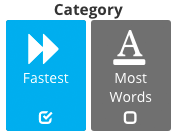




To ensure the fairest competition between classes, the leaderboard defaults to show results grouped by age brackets.
Use the icons at the top of the Leaderboard to drill down by Country and State.
Only classes where the teacher or school administrator has set the age level of the class will be shown on the age-based leaderboard. This can be set using the “Edit Class Details” button on the class management screen. If you have not already done so, please ensure your classes have the correct ages now.
We employ standard deviation filters to ensure that results that are atypical for a student are discounted and not used for the calculation of class results. This methodology assumes that each student will build their skills in a progressive manner and guards against the possibility of others with higher skills speeds artificially inflating a student’s result by working in their account.
Classes with significantly more or less students than typical classes are not displayed in the Leaderboard.
Inactive classes, in which none or only a small number of students have completed questions during the week, will not be displayed on the Leaderboard.
A detailed explanation of the function of the Leaderboards is available at help.edalive.com
Click the Calendar icon to view the Leaderboard results for all classes including your own from last week and previous weeks.
The Leaderboards are re-calculated each week at midnight Australian Eastern Standard Time (Sydney). Each answer is recorded in real time and feeds into this calculation.
When logged in students can view the results for all active classes at their school including their own. This makes it easy for you to have in-school competitions.
Some schools may prefer that classes from their school are not displayed on the Leaderboard. If this is the case, the school administrator can simply uncheck the “Participate in competition” option on the My School screen of the School Administration menu. Please note we cannot remove results retrospectively.